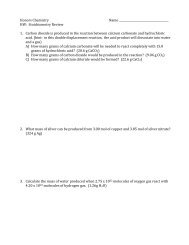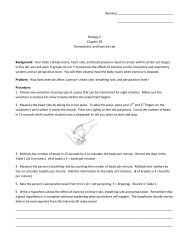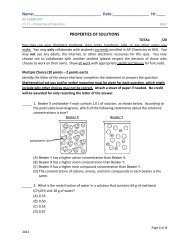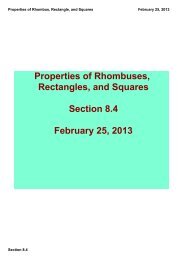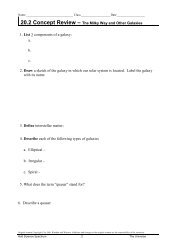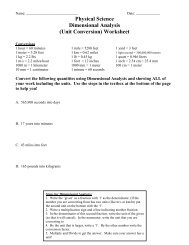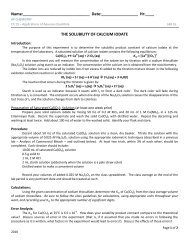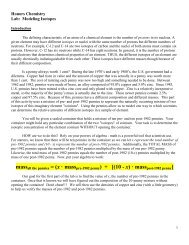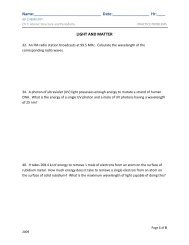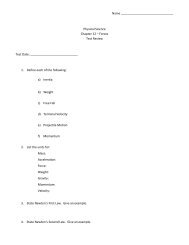Electrochemistry (Ch 17) - AP Chemistry
Electrochemistry (Ch 17) - AP Chemistry
Electrochemistry (Ch 17) - AP Chemistry
You also want an ePaper? Increase the reach of your titles
YUMPU automatically turns print PDFs into web optimized ePapers that Google loves.
4/1/2011<br />
GALVANIC CELLS<br />
• Consider a galvanic cell based on the reaction<br />
Al 3+ (aq) + Mg(s) Al(s) + Mg 2+ (aq)<br />
– The half-reactions are<br />
• Al 3+ + 3 e - Al<br />
E° = -1.66 V<br />
• Mg 2+ + 2 e - Mg<br />
E° = -2.37 V<br />
– Give the balanced cell reaction and calculate E° for the cell.<br />
• 2 Al 3+ (aq) + 3 Mg(s) 2 Al(s) + 3 Mg 2+ (aq)<br />
• E° cell = 0.71V<br />
LINE NOTATION<br />
• Line notation is handy for representing electrochemical cells.<br />
– The anode components are listed on the left and the cathode components are<br />
listed on the right, separated by double vertical lines (indicating the salt bridge<br />
or porous disk).<br />
• For example, the cell on the previous slide would be:<br />
Mg(s) | Mg 2+ (aq) || Al 3+ (aq) | Al(s)<br />
– Phase difference (boundary) is indicated by a single vertical line<br />
• Notice that the substance constituting the anode is far left and cathode is far right<br />
– Commas are used to separate ionic species in the same solution<br />
Pt(s)|ClO 3- (aq), ClO 4- (aq), H + (aq) ||H + (aq), MnO 4- (aq), Mn 2+ (aq)|Pt(s)<br />
<strong>Ch</strong> <strong>17</strong> - <strong>Electrochemistry</strong> 19<br />
<strong>Ch</strong> <strong>17</strong> - <strong>Electrochemistry</strong> 20<br />
COMPLETE DESCRIPTION OF A GALVANIC CELL<br />
• NOTE: A cell will always run spontaneously in the direction that<br />
produces a positive cell potential (E° cell )<br />
• A complete description of a galvanic cell includes:<br />
– The cell potential (always positive for a galvanic cell where E° cell = E° cat – E° an )<br />
and the balanced cell reaction.<br />
– The direction of electron flow, obtained by inspecting the half-reactions and<br />
using the direction that gives a positive E cell .<br />
– Designation of the anode and cathode<br />
– The nature of each electrode and the ions present in each compartment. A<br />
chemically inert conductor is required if none of the substances participating in<br />
the half-reaction is a conducting solid.<br />
DESCRIPTION OF A GALVANIC CELL<br />
• Describe completely the galvanic cell based on the following halfreactions<br />
under standard conditions:<br />
Ag + + e - Ag<br />
Fe 3+ + e - Fe 2+<br />
E° = 0.80 V<br />
E° = 0.77 V<br />
– Ag + (aq) + Fe 2+ (aq) Fe 3+ (aq) + Ag(s) E° cell = 0.03 V<br />
– Electrons flow from Fe 2+ to Ag +<br />
– Anode: Fe 2+ compartment Cathode: Ag + compartment<br />
– Pt(s)|Fe 2+ (aq), Fe 3+ (aq)||Ag + (aq)|Ag(s)<br />
<strong>Ch</strong> <strong>17</strong> - <strong>Electrochemistry</strong> 21<br />
<strong>Ch</strong> <strong>17</strong> - <strong>Electrochemistry</strong> 22<br />
CELL POTENTIAL, ELECTRICAL WORK, AND<br />
FREE ENERGY<br />
Section <strong>17</strong>.3<br />
CELL POTENTIAL AND WORK<br />
• The work that can be done by the electrons transferred<br />
through a wire depends on the “push” (thermodynamics)<br />
behind the electrons.<br />
– This electromotive force (emf) is defined in terms of a potential<br />
difference (in volts) between two points in the circuit (1 V = 1 J/C)<br />
– Cell potential (E ) and work (w) have opposite signs:<br />
w max = –qE max<br />
• In any real, spontaneous process some energy is always wasted – the<br />
actual work realized is always less than the calculated maximum<br />
<strong>Ch</strong> <strong>17</strong> - <strong>Electrochemistry</strong> 23<br />
<strong>Ch</strong> <strong>17</strong> - <strong>Electrochemistry</strong> 24<br />
4






